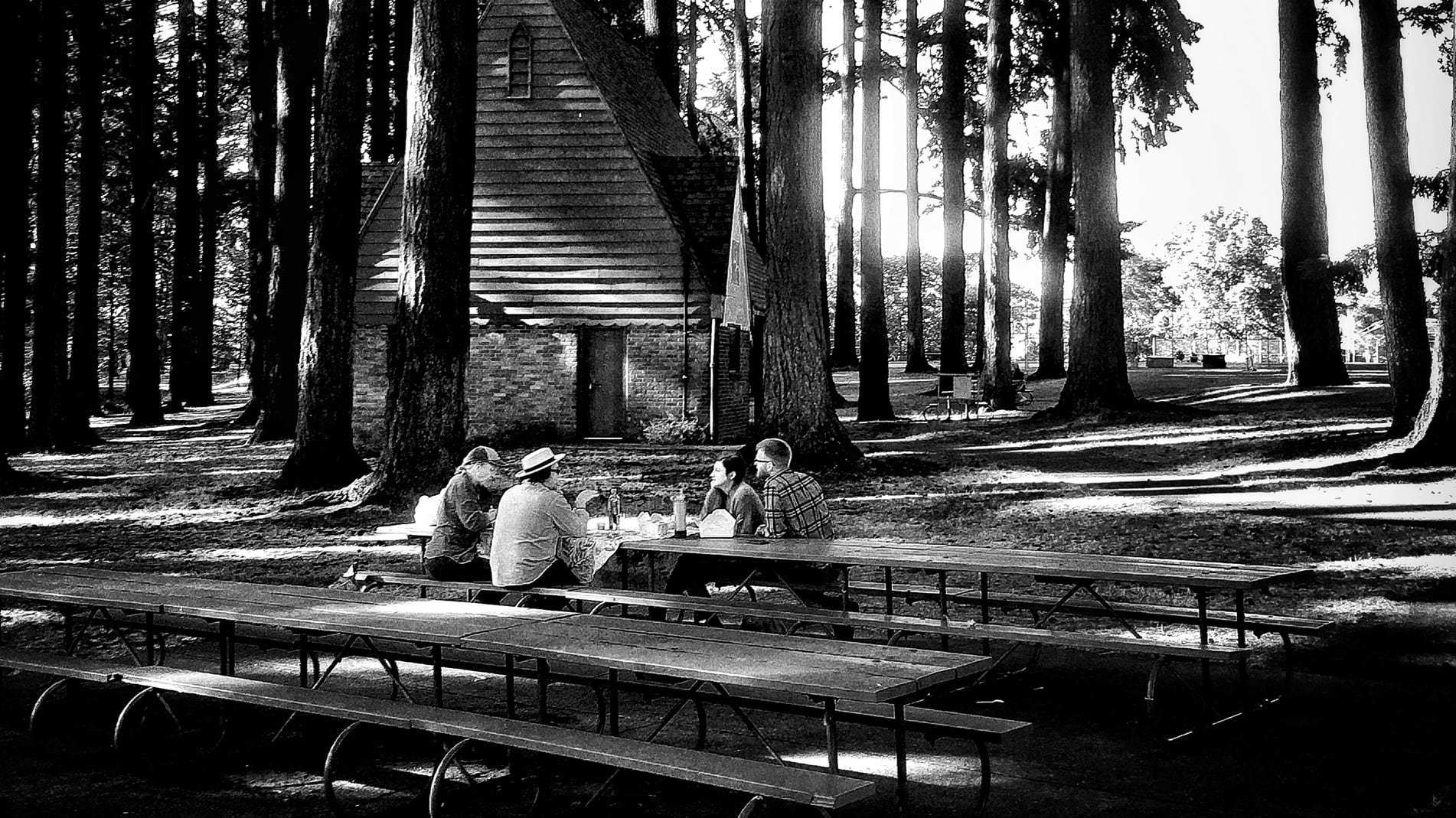David McCarthy’s photography collection The Portlanders (Northwest Review, 169 pages, $44) begins where his memories do—in Sellwood with landmarks of his youth. The Yukon Tavern appears in the book’s second photo with an exterior hardly changed since McCarthy would use it to recognize his grandparents’ neighborhood in the late 1950s.
But a reader can move only three pages down memory lane before the first tent appears in a photograph, tucked into a thicket below the Sellwood Bridge. That’s Portland in the years McCarthy documents (2015-2022), its rugged beauty and communal spirit increasingly pockmarked by suffering.
“To me, this is about what’s happening to the people,” says McCarthy, a recently retired architect, third-generation Oregonian and Southeast Portland resident since 1990.
The Portlanders’ black-and-white palette lends extra drama to overcast skies and an alluvial quality to the concrete, as the book reflects the city with a mirror’s intent, says publisher and editor S. Tremaine Nelson.
You’ll find classically local sights within: a resident belly-sliding in the rare snow and families perched atop Keller Fountain. But the book is broadly organized around unavoidable realities, namely how implements of the classic Pacific Northwest vacation—the tent and RV—backslid into becoming housing-crisis survival netting.
“Everybody’s just trying to live,” says Nelson, adding that McCarthy’s work taught him how many unhoused Portlanders are still working blue-collar jobs every day. “There’s no political statement being made by boiling your water on a Coleman stove before biking to work. This is a book about people trying to survive and make it through the day at the confluence of two gorgeous old rivers.”
The Portlanders marks the first book from the resurrected Northwest Review, the onetime University of Oregon literary journal that published the likes of Ken Kesey and Ursula K. Le Guin for 54 years before its funding was fatally slashed in 2011. Nelson (a former poetry reader for The Paris Review) and a volunteer crew of editors gave Northwest Review a second life in 2020. It’s since published seven issues, including a handful of McCarthy’s photos.
“There was no other book that could possibly have been our first when this is happening in our city,” Nelson says.
McCarthy and Nelson, a born-and-raised Portlander who returned from the East Coast in 2018, undertook the book project last winter, influenced in part by Robert Frank’s The Americans. That iconic 1950s photography project captured American lives seldom seen in Rockwellian veneer and Life magazine gloss. Today, The Portlanders tries to puncture a different dominant narrative: that Portland is dead, ablaze or beyond any recognition.
“I want this to be the document of record of what Portland was like during a period of time when it became politicized and exploited for various national political agendas,” Nelson says.
Still, there’s a fascinating tension to where people are and aren’t in McCarthy’s visuals, compared to The Americans’ emphasis on portraiture. McCarthy often keeps his distance from subjects—he admits to some shyness—defining most shots with the angles of walls, railings, roofs and façades and showing how Portlanders interact with those forms by invitation or desperation. That architectural eye, McCarthy says, informs how he notices temporary structures as well.
“In some cases with the tent arrangements, somebody is thinking about what they’re doing and leaving space for carts and campfires or stoves,” he says. “They’ve arranged things in a way that works for them and their neighbors.”
The photographer’s lens (whether on an iPhone SE, pocket digital Canon or, every so often, a film camera) is often positioned unassumingly, where any pedestrian would wait for a food cart order or scan a crosswalk. From that sidewalk vantage, readers witness the relative emptiness of the pandemic years and could perhaps re-sensitize to how the human beings sleeping in public seemingly outnumber the fire hydrants and newspaper boxes.
McCarthy attributes the book’s visual flow to his poetry classes at the University of Oregon, where he graduated in 1980. The 200-plus photos build momentum and symmetry from page to page, wordlessly pondering the meaning of canopies, for instance. Tents, leafy overhangs, car tarps, covered picnic tables—they’re of a piece in a city where shelter equals existence.
“Here’s the world as we see it now,” McCarthy says of his book. “Maybe not beautiful, but there’s something worth looking at here.”

